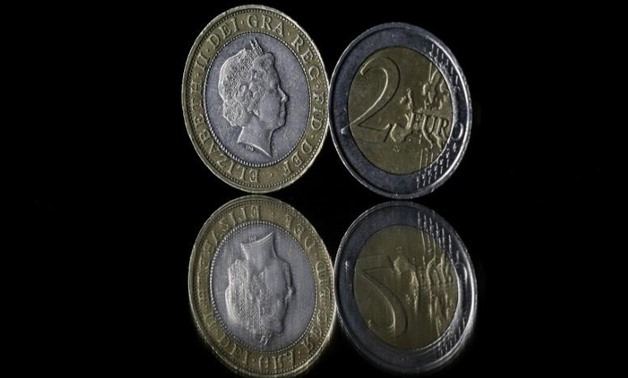
Pound and Euro coins are seen in this picture illustration taken January 18, 2017. REUTERS/Dado Ruvic/Illustration
LONDON - 1 September 2017: As parity between the euro and sterling inches closer, the European Central Bank and Bank of England face a date with destiny that neither of them wants.
This week the euro traded as high as 93 pence which, barring a single day in October last year, is its strongest against sterling for eight years. It has risen 10 percent in a little over three months.
At 93 pence, the euro is roughly 7 percent away from an unprecedented 1-for-1 rate with sterling. Parity was almost reached in December 2008 following a stunning 45 percent surge in little over a year, but it topped out at 98 pence.
An even stronger euro makes it more difficult for the ECB to achieve its inflation goals, while another lurch lower in the pound could push UK inflation even higher, eroding real earnings further, and imperilling consumer spending.
Outright market intervention is unlikely, but both central banks could resort to verbal intervention to cool any volatility if the move toward parity was too quick for their liking.
On top of economic concerns, politics could also loom large over the exchange rate as the fraught and laboured UK-euro zone negotiations over Brexit intensify in the coming months ahead of Britain’s departure from the European Union in March 2019.
The euro/sterling rate matters because the economic ties between Britain and the euro zone are so strong. Nearly half of all UK exports go to the euro zone and Britain accounts for 13.4 percent of exports from the 19-nation bloc, once trade between euro zone countries is excluded, second only to the United States’s 13.6 percent.The euro accounts for a near-50 percent weight in sterling’s trade-weighted index, and sterling an almost 15 percent weighting in the trade-weighted euro. Central banks base inflation and growth forecasts on trade-weighted exchange rates rather than bilateral ones.
BREATHING SPACE
The euro is the best performing major currency in the world this year, partly reflecting how well the euro zone economy is doing and partly on shifting expectations on how high U.S. interest rates will go and on the Brexit-tinted UK economic outlook.
The 19-nation bloc is expanding at its fastest pace in six years and this week analysts at Moody’s became the latest to raise their growth forecasts even higher.
The euro’s rise is beginning to worry a growing number of ECB policymakers, and will almost certainly be discussed at the ECB’s policy meeting next week.
Euro zone inflation has fallen short of the ECB’s target of close to but below 2 percent for most of the last five years. A 10 percent rise in the euro corresponds with a fall of nearly 0.5 percentage points in inflation over the next 12 months.
So another 7 percent higher from here might be difficult for some policymakers to stomach. That said, broader financial conditions in the euro zone remain extremely loose and the euro’s trade-weighted is only up a relatively modest 5 percent this year.
On the other side, sterling’s low exchange rate supports UK growth by making exports more competitive, but lifts inflation by making imports more expensive. Unfortunately for the Bank of England, the boost to growth takes much longer to emerge than inflationary pressures.
Sterling has plunged 15 percent since Britons voted to leave the EU in June last year, driving prices higher. Consumer price inflation is currently 2.6 percent and has now overshot the BoE’s 2 percent target for six months in a row.
Growth hasn’t slumped since the Brexit vote as much as many economists feared. But the weaker pound has yet to filter into GDP growth rates - UK GDP expanded 0.3 percent in the second quarter, half the pace of the euro zone and wider EU average.
Another 7 percent slide in the exchange rate would complicate the BoE’s trade-off between the potential boost to growth in the longer term and squeeze on already embattled consumers in the near term.
The post-referendum surge in inflation means real wages are falling again, not long after emerging from the longest run of real wage declines (2010-14) in at least half a century.
Fortunately for the ECB and BoE, euro/sterling has risen so much in such a relatively short space of time that a pause seems likely. Both would welcome the breathing space.


Comments
Leave a Comment